#Empire of Nicaea
Text

Et voila! I know you’ve all been waiting for it 🤭🤭
#byzantium#byzantine empire#byzantine empress#theodora palaiologina#anna of savoy#maria of trebizond#nicaean empire#empire of nicaea#13th century#14th century#15th century#history art#digital art#pride#lesbian#trans pride#pride art#greek tag#roman tag#italian tag#german tag#rus tag#bulgar tag#outremer#hungary tag#armenia tag#france tag
10 notes
·
View notes
Text
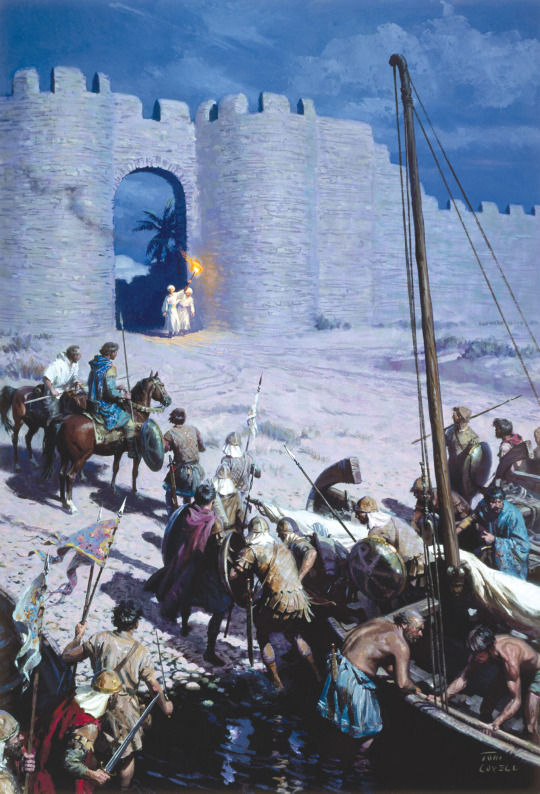
Byzantine Soldiers Sneaking Into Walled City Of Nicaea
by Tom Lovell
#siege of nicaea#art#tom lovell#byzantine#soldiers#byzantium#first crusade#crusades#crusade#medieval#middle ages#history#christianity#christian#nicaea#siege#fortress#castle#byzantine empire#constantinople#seljuk#turks#manuel boutoumites#walls
99 notes
·
View notes
Text
@maaruin
Hinduism is probably a good example for how Roman-Platonist Monotheism would look like without the Jewish origin of Christianity: the theology is monotheist but to an outside observer the rituals look like they are honoring various gods, because polytheist practices have been re-interpreted in a monotheist way. Christianity is unusual not in its monotheist beliefs, but in that it required its followers to stop performing the traditional (polytheist) rituals.
I want to expand on this bc it touches something else McClellan mentions--how being the organized faith of the Empire really changed Christianity, or at least Nicene Christianity. Before it became institutionalized, there was a lot of room in early Christianity for different, contradictory Christologies (like Arianism, which was basically mainstream at one point); it's only with the Council of Nicaea that a compromise form of all these Christologies has to be hammered out (because the institutional church needs dogmatic harmony), and the boundaries of orthodox theology have to be policed--and can be, eventually with the full backing of state power. Before the most you could do was expel members of your church who disagreed with you, maybe refuse association with other churches whose theology differed too much. Once you have state backing you can use that authority to exclude heretics; and, later, once you are the official religion of the Empire, you can have heretics punished by the state.
I think this harsh ideological boundary maintenance really becomes a part of every state-backed church, but of course it's the Roman one that is by far the most powerful and most widespread; and even post-Great Schism and the fall of the western empire, the need for Catholic rulers to be in good with the Pope, and thus to enforce Christian orthodoxy within their territory, has the same boundary-maintenance effect.
McClellan contends that without this forced institutional compromise--which is what the Trinity is; "three persons with one substance" and stuff like "100% divine and 100% human" is not just "a mystery," it's functionally a nonsensical contradiction, and the reason why so many attempts to explain the Trinity fall into heresies like modalism or partialism is because the Trinity is wording-by-committee aimed at producing phraseology that most people at this one ecumenical council could tolerate, even if they didn't like it.
And by "most people" here we mean a very particular kind of educated Greco-Roman elite; a lot of early theology is shaped by what is conceptually acceptable to these guys, steeped in stuff like Neo-Platonism, and maybe doesn't have all that much to do with the peasant religion version of Christianity elsewhere (indeed, get your average theologically-untrained Christian of any era to try to explain something like the Trinity and I guarantee ninety-nine times out of ten they will produce an explanation that is technically a heresy).
All of which is to say I agree; a counterfactual "monotheistic" late-antiquity religion in a world without Christianity, but with the same Greco-Roman influences, would look very much like Hinduism; it would have a big split between, like, the everyday version of the religion and the theologically elucidated elite version of the religion; and I think it's the latter that would resemble Nicene Christianity on a lot of points. But then, folk Christianity often is very different from "orthodox" Nicene Christianity in the world we do inhabit, also.
68 notes
·
View notes
Photo
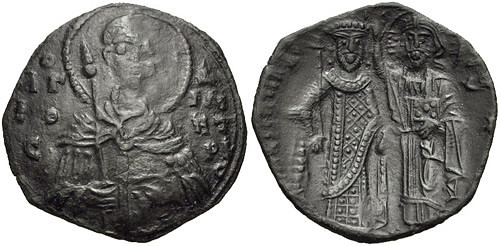
Thessaly and the Duchy of Neopatras
Thessaly was an independent state in medieval Greece from 1267 or 1268 to 1394 CE, first as the Greek-ruled Thessaly and later as the Catalan and Latin-ruled Duchy of Neopatras. Under its sebastokrators, Thessaly was a thorn in the side of the Byzantine Empire and an ally of the Latin states in Greece and southern Italy. Following the death of the last Thessalian sebastokrator in 1318 CE, the Duchy of Neopatras was established by the Catalans and combined with the Duchy of Athens, with the two states mostly sharing the same rulers and fortunes until Thessaly was finally conquered by the Ottoman Turks in 1423 CE.
Beginnings in Epirus
Following the Fourth Crusade's sacking of Constantinople in 1204 CE, the Byzantine Empire splintered into a series of successor states. Thessaly was originally held by the regional Greek leader Leo Sgouros, but when the Latin crusaders arrived, the territory was quickly taken over by Latin lords under the nominal leadership of Boniface of Montferrat, the new King of Thessalonica (r. 1205-1207 CE). Latin rule in Thessaly was short-lived, however, and in 1212 CE, Michael I Komnenos Doukas of Epirus (r. 1205-1215 CE) occupied central Thessaly, including the key city of Larissa, and the rest of Thessaly was conquered by his half-brother and successor, Theodore Komnenos Doukas (r. 1215-1230 CE). Epirus was one of the three long-lasting Greek (or rather Roman) successor states to the Byzantine Empire, and it was initially quite successful, conquering Thessalonica, restyling itself the Empire of Thessalonica, and advancing almost to the gates of Constantinople itself before Theodore suffered a horrific defeat at the Battle of Klokotnitsa in 1230 CE.
In the aftermath of Klokotnitsa, Manuel Komnenos Doukas (r. 1230-1241 CE) took up power in Thessalonica while his relative Michael II Komnenos Doukas (r. 1230-1267/1268 CE) became the ruler of Epirus. Thessaly was ruled by the Empire of Thessalonica during this decade of contraction, but when Manuel was ousted from Thessalonica in 1237 CE by the returned Theodore, he went to Thessaly, where he ruled the region as an independent state from 1239 to 1241 CE. Upon his death, Thessaly fell to Michael II of Epirus, being reincorporated into the Despotate of Epirus. The region was briefly occupied by the Empire of Nicaea in 1259 but was reoccupied by Epirote forces the following year.
Continue reading...
36 notes
·
View notes
Note
How did all the heresies and theological arguments of the Late Roman Empire lead to "the Arab caliphates getting a decent navy and winning the Battle of the Masts"?
This is actually a fascinating story about the nature of the religious world and religious politics in the Late Roman and Byzantine Empires and the Rashidun Caliphate.
Because heresies and theological arguments tended to start at the level of bishops and patriarchs fighting with the bishops and patriarchs of other metropoles (and that filters out to which missionaries were sent where), there were strong regional variations as to which position was in the local majority.
Skipping over the Arian controversy because it's not relevant to the Battle of the Masts, Cyril of Alexandria was the leader of the Monophysite faction ("physis" meaning "nature," i.e Christ has one nature, which tracks with the Council of Nicaea's declaration that he had one "essence"), and his dyophysite (meaning two "natures") rivals were based out of Antioch - and Alexandria and thus Egypt became Monophysite. However, Constantinople and Anatolia were dyophysite and worked to make sure that the Second Council of Ephesus and the Council of Chalcedon declared monophysitism a heresy and dyophysitism as Orthodoxy, thus leading to the Chalcedonian Schism.

Following on from this, the emperors Justin II and Justinian I were Orthodox. Now, Justinian tried to end the Schism through the Second Council of Constantinople in 553, but this didn't really work and it remained state policy to persecute Monophysites. However, the empress Theodora was Monophysite and acted as patroness and political defender of Monophysites throughout the empire - which made her very popular in Egypt...and with the Greens in the Hippodrome, who were also Monophysites. Naturally, if the Greens were Monophysite, the Blues were Orthodox, because why not turn your sports rivalry into a religious rivalry and a pseudo-political party system? It's not called the Byzantine Empire because it's simple.
Even though Theodora was a Green, Justinian supported the Blues, which meant that no matter what your sports team or religious views or pseudo-partisanship you could support the imperial family. (Indeed, many historians think that the two at least somewhat arranged their religious and sports affiliations with this in mind.) This worked...up until the Nika riots ended up with Belisarius turning the Imperial army on the sports fans turned revolutionary rioters in the Hippodrome, leading to the deaths of as many as 30,000 people.
And so it went, with Alexandria tending to be the losers in the monoergism vs. dyoergism (does Christ have one "energy" or two?) debate, and the monolethitism vs. dyolethetism (does Christ have one "will" or two?) debate. Notably, these debates saw the Emperors of the time trying to get the Church to adopt a compromise (both monoergism and monothelitism were essentially an attempt by the Emperor Heraclius and his Patriarch to find a new theological formulation that the Alexandrians could live with while pointing urgently in the direction of first the Persians and then the Arabs) and failing due to religious partisans digging in their heels, or Emperors siding violently with one side or the other, ironically in the name of Imperial unity.
And this brings us to the Arab Conquest that gave birth to the Rashidun Caliphate. Now, the Christian population of Alexandria was not exactly thrilled about suddenly being ruled over by Muslim Arabs in 642...but in a genius stroke of enlightened self-interest, the Rashidun Caliphate adopted a policy whereby non-Muslim subjects (dhimmis) would be left alone in terms of religious matters as long as they paid their jizya taxes on non-Muslims (with the idea being to create a financial incentive to convert). While this wasn't the most popular, the Alexandrians realized that having to pay religious taxes and then getting left alone in peace and quiet to be Monophysite was a much better deal than having to pay Byzantine imperial taxes and getting religiously persecuted all the damn time.
This mattered geostrategically, because the Port of Alexandria was one of the largest ports in the Mediterranean, and thus had one of the largest shipyards and a lot of shipbuilders, and a hell of a lot of trained ex-Roman sailors and marines who were heavily Monophysite. These recently-unemployed sailors and marines were very happy to work for the Rashidun Caliphate, especially when the Caliphs started to shift resources into the navy to combat Byzantine dominance on the seas. Thus, only a few years after the Rashidun conquest of Egypt in 642, the Arab navy was suddenly able to fight on equal terms with the Byzantine navy - and then started kicking their ass.

This at last brings us to the Battle of the Masts in 655, where an Arab fleet (crewed mostly by Monophysite Egyptians) of 200 ships under the command of admiral Abu al-A'war came into contact with a Byzantine fleet of 500 ships led by the Emperor Constans II off the coast of Lycia...and smashed it to pieces. According to the historian al-Tabari, it was called the Battle of the Masts because there were rough seas and both fleets lashed themselves together to allow for marine boarding operations, so that soldiers were literally crossing from mast to mast. Constans II supposedly only managed to escape by changing uniforms with one of his subordinates as a disguise.
The defeat was so crippling that Constantinople was brought under siege for the first time by the Rashidun that same year, although that brief siege (the brevity of which is why historians refer to the siege of 674-678 as the "First Arab Siege of Constantinople") was unsuccessful due to a storm that sunk the Arab ships carrying the artillery and siege engines that the land army was counting on. Naturally, the Byzantines attributed this storm and the first Arab civil war that broke out in 655 (which bought the Byzantines some desperately-needed breathing room) to divine intervention.
Just to show how the past is always with us, I wanted to share a bit of a statement by the Coptic Orthodox Church of the Southern United States:
"The Coptic Orthodox Church was accused of being 'Monophysite' in the Council of Chalcedon. The term monophysite comes from two Greek words meaning "single nature". Monophysitism merged Christ's humanity into His divinity so that effectively it meant that in Christ there was only one single nature, a divine nature. This is NOT what the Coptic Orthodox believes. We believe that "Christ's divinity parted not from His humanity, not for a single moment nor a twinkling of an eye" and we recite this statement in every liturgy. As a result, we are Miaphysite and not Monophysite. Miaphysitism (one nature) means the Lord Jesus Christ is perfect human and perfect divine and these two natures are united together without mingling, nor confusion, nor alteration in one nature; the nature of God incarnate."
42 notes
·
View notes
Photo
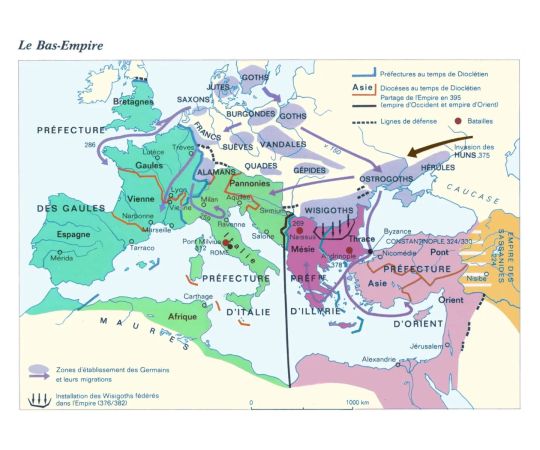
The Lower Empire
« Atlas historique Larousse » sous la direction de Georges Duby, édition revue et corrigée, 1987
by cartesdhistoire
In the 3rd and 4th centuries, the Empire faced a triple threat: to the north, the Germans, numerous, unstable, and warlike, pressed on its borders; to the east, the Sassanid Persians, victorious over the Arsacid Parthians, constituted the only organized state opposing Rome; in the south, the Saharan nomads posed the least dangerous threat. The crisis reached its peak from 256 to 269, when these enemies coordinated their attacks. However, from Claudius II (268–270) to Diocletian (284–305), the Illyrian Emperors managed to stabilize the situation, despite significant challenges (such as the Alamanni and Franks invading Gaul in 275). At times, they negotiated deals, notably with the Sassanids. In 332, the Goths from the lower Danube, defeated, agreed to an unequal alliance treaty with Constantine. In exchange for subsidies and the right to trade with Rome, they pledged to provide troops to the Emperor upon request. They remained loyal to the Constantinian dynasty thereafter, supporting Constantius II against Magnentius in 351-353 and backing the attempted usurpation of Procopius against Valens in 365.
Constantine organized the first universal council in 325 at Nicaea, bringing together bishops to achieve theological unity within Christianity. Some external bishops (Persians and Goths) attended, and Constantine, as Roman Emperor, presented himself as the natural protector of Christians worldwide.
Constantine's establishment of Constantinople as the second capital shifted the empire's center of gravity (331). Constantine's three sons succeeded him, and after several episodes of civil wars, Constantius II (337-361) emerged victorious from the conflicts. He imbued power with a hieratic, sacred, and Christian character.
However, stabilization primarily came from the reorganization of the army (stationing fixed units at the borders and maintaining a mobile reserve at the rear), leading to victories over Persians, Goths, and Franks, ensuring half a century of tranquility. This peace was reinforced thanks to the resolute character of Valentinian I (364–375).
41 notes
·
View notes
Photo

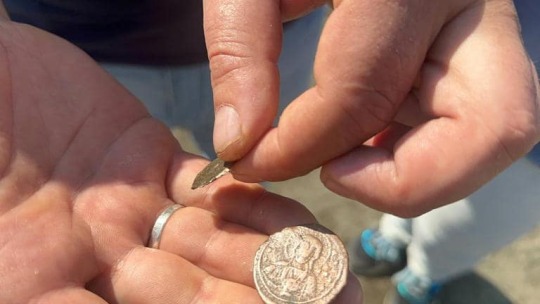
2,000-Year-Old Coins Surface with Lake Iznik withdrawal in Turkey
With the withdrawal of Lake Iznik in the northwest of Türkiye, the ancient coins found at the bottom of the water began to be found by the locals.
In Iznik, the world-famous historical city of Bursa, which is on the temporary heritage list of UNESCO and expected to enter the main list this year, a couple walking on the shore of Lake Iznik found a 2,000-year-old historical coin.
Locals began discovering ancient coins after the lake dried up, possibly from the historical basilica that was once submerged beneath Lake Iznik but rose above the water in 2014.
Ismail Yıldırım, walking with his wife and children, noticed that the coins were historical as the cash had figures of Jesus and relief inscriptions.
The Yildirim couple handed over the coins to Iznik Archeology Museum. The museum officials, who examined the coins, stated that the coin, which is the figure of Jesus Christ, belongs to the 9th century, and the other coin belongs to the Hellenistic period.
Iznik, a district of northwestern Bursa province dating back to the 4th century BC, is significant for both Muslims and Christians, with many sites from the era of Bithynian, Roman, Seljuk, and Ottoman civilizations.
According to geographer Strabo, the ancient town was founded in 316 BC by Antigonos, the commander of Alexander the Great (356-323 B.C). It is also reported that Lysimachos, another general of Alexander, took the city and renamed it after his wife Nicaea.
İznik enjoyed a period of expansion and prosperity under Roman rule.
During the Byzantine period, İznik grew in importance as a religious center, especially after Emperor Constantine converted to Christianity in 313 AD. The first Christian Council, known as the Great Council of Nicaea, was held in 325 AD in İznik, with the participation of over three hundred bishops from various parts of the empire.
By Oğuz Büyükyıldırım.
#2000-Year-Old Coins Surface with Lake Iznik withdrawal in Turkey#jesus christ#collectable coins#ancient artifacts#archeology#archeolgst#history#history news#ancient history#ancient culture#ancient civilizations
29 notes
·
View notes
Text
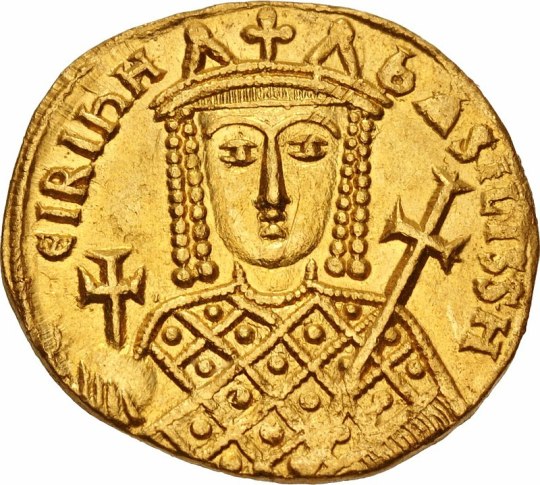
Irene of Athens (750/756 – 9 August 803), surname Sarantapechaina (Σαρανταπήχαινα), was Byzantine empress consort to Emperor Leo IV from 775 to 780, regent during the childhood of their son Constantine VI from 780 until 790, co-ruler from 792 until 797, and finally empress regnant and sole ruler of the Eastern Roman Empire from 797 to 802. A member of the politically prominent Sarantapechos family, she was selected as Leo IV's bride for unknown reasons in 768. Even though her husband was an iconoclast, she harbored iconophile sympathies. During her rule as regent, she called the Second Council of Nicaea in 787, which condemned iconoclasm as heretical and brought an end to the first iconoclast period (730–787). Her public figure was very polarizing during her 5 year reign, as most saw a woman not right to rule solely. Her reign as such made her the first ever empress regnant, ruling in her own right, in Roman and Byzantine imperial history.
She was influential in government policies during her husband's reign. His untimely death caused the throne to actually fall to her, leaving her solely in charge. As Irene's son Constantine reached maturity, he began to move out from under the influence of his mother. In the early 790s, several revolts tried to proclaim him as sole ruler. One of these revolts succeeded, but in 792 Irene was re-established in all imperial powers as co-emperor with Constantine. In 797, Irene organized a conspiracy in which her supporters gouged out her son's eyes, maiming him severely. He was imprisoned and probably died shortly afterwards. With him out of the way, Irene proclaimed herself sole ruler. Pope Leo III—already seeking to break links with the Byzantine East—used Irene's alleged unprecedented status as a female ruler of the Roman Empire to proclaim Charlemagne as Emperor of the Romans on Christmas Day of 800 under the pretext that a woman could not rule and so the throne of the Roman Empire was actually vacant. A revolt in 802 overthrew Irene and exiled her to the island of Lesbos, supplanting her on the throne with Nikephoros I. Irene died in exile less than a year later.
#Irene of Athens#House Sarantapechos#women in history#solidus#coin#photo#photography#eastern roman empire
11 notes
·
View notes
Text
SAINT OF THE DAY (January 13)

On January 13, Catholics celebrate St. Hilary of Poitiers, a fourth-century philosopher whose studies made him a champion of Orthodox Trinitarian theology during one of the most difficult periods of Church history.
He protected the Church and its members by brilliantly defending the sacred humanity of Jesus while also defeating Arianism, which denied Christ's placement within the Trinity.
St. Hilary was a gentle and courteous man, devoted to writing some of the greatest theology on the Trinity and was like his Master in being labeled a "disturber of the peace."
In a very troubled period in the Church, his holiness was lived out in both scholarship and controversy.
Little is known about St. Hilary's life before he became a bishop. Fittingly, what historians do know about him derives mostly from personal details contained within his extensive theological works.
Those remarks indicate that Hilary was born to a pagan family in present-day France, most likely around 310 – three years before the Roman Empire declared its official toleration of Christianity.
Hilary himself grew up apparently without any significant Christian influence but received an otherwise comprehensive education in the Latin and Greek classics.
Not unusual for his era, he rigorously studied both Greek philosophy and the Bible.
Like many other early Church Fathers, he came to accept the truth of the Bible by recognizing its compatibility with philosophy and the sciences.
This was a gradual process for him, however, and it was not until 345 – by which time he was already married and had a daughter– that Hilary committed himself to full membership in the Catholic Church by receiving baptism with the rest of his family.
His rise within the Church, however, was not gradual at all. Around 353, the people of Poitiers called for him to be made their bishop.
By its nature, the position involved tremendous responsibility as well as significant personal sacrifice.
While the early church permitted some married men to become bishops, they were traditionally required to practice celibacy within marriage, and many adopted a radically simplified lifestyle akin to monasticism.
There are indications that Hilary followed this ascetic path, once ordained.
Moreover, Hilary's election as the Bishop of Poitiers coincided with the second wave of the Church's first great doctrinal controversy in which he would play a significant role.
Although the Council of Nicaea in 325 had confirmed the Church’s rejection of Arianism – which claimed Jesus was only human, not divine – powerful forces within both the Church and the empire clung to the heresy.
Only a few years after his assumption of episcopal rank, Hilary found himself virtually alone in defending Jesus’ deity before a hostile crowd of bishops in the southern French region of Gaul.
The bishops appealed to Emperor Constantius II, who favored a modified version of Arianism and declared Hilary��s exile from Gaul.
Constantius II did not likely suspect that by banishing Hilary to Phrygia, he would inspire the bishop to mount an even greater defense of orthodox theology.
There, he wrote his most important work, “On the Trinity,” showing the Bible’s consistent witness to the central mystery of Christian faith.
Remarkably, this staunchly Orthodox bishop also showed great charity toward those he believed were honestly mistaken.
He worked closely with groups of clergy and faithful whose formulations of dogma he perceived to be merely imperfect or imprecise, but not intentionally heretical, to support what was correct in their understanding and lead them into full adherence with tradition.
Hilary even traveled to Constantinople during his exile to explain to the city’s bishops why their emperor was not orthodox.
After the death of Constantius II in 361, Hilary was able to return to his diocese at Poitiers.
Once exiled for opposing Arianism in Gaul, he lived to see it squarely condemned in the local church after his return.
Although deeply committed to the leadership of his own diocese, Hilary took steps late in his life to support orthodox teaching in other regions.
Most significantly, he denounced Auxentius, the Arian bishop of Milan.
Subsequent opposition to Auxentius led to his succession by St. Ambrose of Milan who, in turn, greatly influenced the conversion of St. Augustine.
St. Hilary died at Poitiers in 367, after having passed on his teachings and way of life to a number of students, including St. Martin of Tours.
Long regarded and celebrated as a saint within the Church, St. Hilary was also declared a Doctor of the Church in 1851.
2 notes
·
View notes
Text
Events 1.1 (before 1830)
153 BC – For the first time, Roman consuls begin their year in office on January 1.
45 BC – The Julian calendar takes effect as the civil calendar of the Roman Empire, establishing January 1 as the new date of the new year.
42 BC – The Roman Senate posthumously deifies Julius Caesar.
193 – The Senate chooses Pertinax against his will to succeed Commodus as Roman emperor.
404 – Saint Telemachus tries to stop a gladiatorial fight in a Roman amphitheatre, and is stoned to death by the crowd. This act impresses the Christian Emperor Honorius, who issues a historic ban on gladiatorial fights.
417 – Emperor Honorius forces Galla Placidia into marriage to Constantius, his famous general (magister militum) (probable).
947 – Emperor Tai Zong of the Khitan-led Liao Dynasty captures Daliang, ending the dynasty and empire of the Later Jin.
1001 – Grand Prince Stephen I of Hungary is named the first King of Hungary by Pope Sylvester II (probable).
1068 – Romanos IV Diogenes marries Eudokia Makrembolitissa and is crowned Byzantine Emperor.
1259 – Michael VIII Palaiologos is proclaimed co-emperor of the Empire of Nicaea with his ward John IV Laskaris.
1438 – Albert II of Habsburg is crowned King of Hungary.
1500 – Portuguese explorer Pedro Álvares Cabral discovers the coast of Brazil.
1502 – The present-day location of Rio de Janeiro, Brazil, is first explored by the Portuguese.
1515 – Twenty-year-old Francis, Duke of Brittany, succeeds to the French throne following the death of his father-in-law, Louis XII.
1527 – Croatian nobles elect Ferdinand I, Archduke of Austria as King of Croatia in the 1527 election in Cetin.
1600 – Scotland recognises January 1 as the start of the year, instead of March 25.
1604 – The Masque of Indian and China Knights is performed by courtiers of James VI and I at Hampton Court.
1651 – Charles II is crowned King of Scotland at Scone Palace.
1700 – Russia begins using the Anno Domini era instead of the Anno Mundi era of the Byzantine Empire.
1707 – John V is proclaimed King of Portugal and the Algarves in Lisbon.
1739 – Bouvet Island, the world's remotest island,[21] is discovered by French explorer Jean-Baptiste Charles Bouvet de Lozier.
1772 – The first traveler's cheques, which could be used in 90 European cities, are issued by the London Credit Exchange Company.
1773 – The hymn that became known as "Amazing Grace", then titled "1 Chronicles 17:16–17, Faith's Review and Expectation", is first used to accompany a sermon led by John Newton in the town of Olney, Buckinghamshire, England.
1776 – American Revolutionary War: Norfolk, Virginia is burned by combined Royal Navy and Continental Army action.
1776 – General George Washington hoists the first United States flag, the Grand Union Flag, at Prospect Hill.
1781 – American Revolutionary War: One thousand five hundred soldiers of the 6th Pennsylvania Regiment under General Anthony Wayne's command rebel against the Continental Army's winter camp in Morristown, New Jersey in the Pennsylvania Line Mutiny of 1781.
1788 – The first edition of The Times of London, previously The Daily Universal Register, is published.
1801 – The legislative union of Kingdom of Great Britain and Kingdom of Ireland is completed, and the United Kingdom of Great Britain and Ireland is proclaimed.
1801 – Ceres, the largest and first known object in the Asteroid belt, is discovered by Giuseppe Piazzi.
1804 – French rule ends in Haiti. Haiti becomes the first black-majority republic and second independent country in North America after the United States.
1806 – The French Republican Calendar is abolished.
1808 – The United States bans the importation of slaves.
1810 – Major-General Lachlan Macquarie officially becomes Governor of New South Wales.
1822 – The Greek Constitution of 1822 is adopted by the First National Assembly at Epidaurus.
2 notes
·
View notes
Text
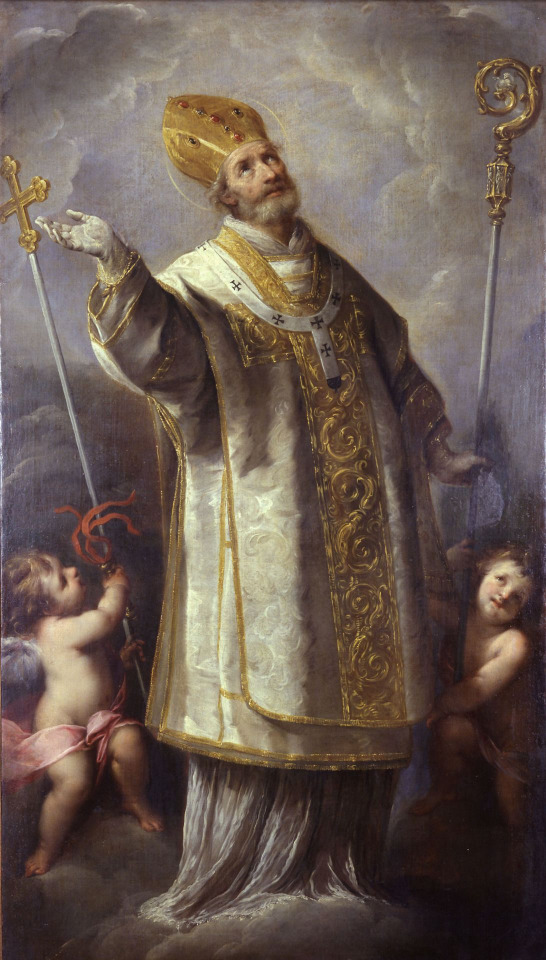
THE DESCRIPTION OF SAINT AMBROSE OF MILAN
Feast Day: December 7
"It is preferable to have a virgin mind than a virgin body. Each is good if each be possible; if it be not possible, let me be chaste, not to man but to God."
Like Augustine himself, the older Ambrose, born around 340, was a highly educated man who sought to harmonize Greek and Roman intellectual culture with the Catholic faith. Trained in literature, law, and rhetoric, he eventually became the governor of Liguria and Emilia, with headquarters at Milan. He manifested his intellectual gifts in defense of Christian doctrine even before his baptism.
While Ambrose was serving as governor, a bishop named Auxentius was leading the diocese. Although he was an excellent public speaker with a forceful personality, Auxentius also followed the heresy of Arius, which denied the divinity of Christ. Although the Council of Nicaea had reasserted the traditional teaching on Jesus' deity, many educated members of the Church – including, at one time, a majority of the world's bishops – looked to Arianism as a more sophisticated and cosmopolitan version of Christianity. Bishop Auxentius became notorious for forcing clergy throughout the region to accept Arian creeds.
At the time of Auxentius' death, Ambrose had not yet even been baptized. But his deep understanding and love of the traditional faith were already clear to the faithful of Milan. They considered him the most logical choice to succeed Auxentius, even though he was still just a catechumen. With the help of Emperor Valentinan II, who ruled the Western Roman Empire at the time, a mob of Milanese Catholics virtually forced Ambrose to become their bishop against his own will. Eight days after his baptism, Ambrose received episcopal consecration on Dec. 7, 374. The date would eventually become his liturgical feast.
Bishop Ambrose did not disappoint those who had clamored for his appointment and consecration. He began his ministry by giving everything he owned to the poor and to the Church. He looked to the writings of Greek theologians like St. Basil for help in explaining the Church's traditional teachings to the people during times of doctrinal confusion. Like the fathers of the Eastern Church, Ambrose drew from the intellectual reserves of pre-Christian philosophy and literature to make the faith more comprehensible to his hearers. This harmony of faith with other sources of knowledge served to attract, among others, the young professor Aurelius Augustinus – a man Ambrose taught and baptized, whom history knows as St. Augustine of Hippo.
Ambrose himself lived simply, wrote prolifically, and celebrated Mass each day. He found time to counsel an amazing range of public officials, pagan inquirers, confused Catholics and penitent sinners. His popularity, in fact, served to keep at bay those who would have preferred to force him from the diocese, including the Western Empress Justina and a group of her advisers, who sought to rid the West of adherence to the Nicene Creed, pushing instead for strict Arianism. Ambrose heroically refused her attempts to impose heretical bishops in Italy, along with her efforts to seize churches in the name of Arianism. Ambrose also displayed remarkable courage when he publicly denied communion to the Emperor Theodosius, who had ordered the massacre of 7,000 citizens in Thessalonica leading to his excommunication by Ambrose. The chastened emperor took Ambrose's rebuke to heart, publicly repenting of the massacre and doing penance for the murders. "Nor was there afterwards a day on which he did not grieve for his mistake," Ambrose himself noted when he spoke at the emperor's funeral.
The rebuke spurred a profound change in Emperor Theodosius. He reconciled himself with the Church and the bishop, who attended to the emperor on his deathbed. St. Ambrose died in 397. His 23 years of diligent service had turned a deeply troubled diocese into an exemplary outpost for the faith. His writings remained an important point of reference for the Church, well into the medieval era and beyond. St. Ambrose has been named one of the 'holy fathers' of the Church, whose teaching all bishops should 'in every way follow.'
Ambrose joins Augustine, Jerome, and Gregory the Great as one of the Latin Doctors of the Church.
#random stuff#catholic#catholic saints#ambrose of milan#san ambrocio#saint ambrose#beekeepers#candlemakers#doctor of the church
2 notes
·
View notes
Text
Saints&Reading: Friday, March 29, 2024
march 16_ march 29
Venerable Christodulus, wonderworker of Patmos (1093)
VENERABLE CHRISTODULUS, WONDERWORKER OF PATMOS, MONK (1093)
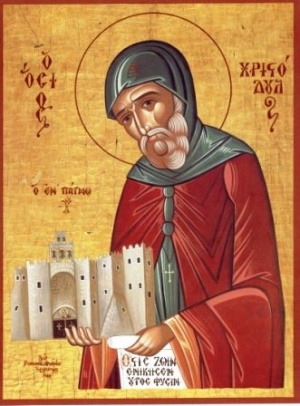
Our Venerable Father Christódoulos 1) was born near Nicaea of Bithynia circa 1020. His parents' names were Theodore and Anna, and their son received the name John in Holy Baptism. He was renowned as an ascetic and a physician throughout the Byzantine Empire.
In 1043 he was tonsured on Mount Olympus, where, under the guidance of the Elders, he received a broad education. After the death of his Spiritual Father, he made a pilgrimage to the holy places in 1045. He visited Rome and Palestine, and he lived in Asia Minor, and on some Greek islands, where he founded several monasteries.
After the Saracen invasion of Palestine, Father Christódoulos left the Holy Land and in 1070 settled on Mount Latmos, in the stavropegial Monastery of the Theotokos in northwestern Karia. Soon he was chosen as the Superior of that monastery. In 1076, Patriarch Cosmas I of Constantinople installed Father Christódoulos as Archimandrite over all the Latmian monasteries. From 1076–1079, he labored to build and fortify monasteries.
In 1079 the Latmian monasteries were destroyed by the Seljuk Turks. The Saint took refuge with his small community in the city of Strovilos on the Aegean coast, where the hermit Arsenios placed him in charge of his monastery. Father Christódoulos soon moved to the nearby island of Kos, the least affected by Muslim incursions. There Arsenios had several estates, and on Mount Pelion, at the latter's suggestion, Christódoulos founded the Kastrian Monastery of the Most Holy Theotokos in 1080.
In 1087, he founded a monastery on the neighboring island of Leros. In addition, during his stay on the island of Kos, Saint Christódoulos organized an expedition to Mount Latmos in order to rescue the books from the monastic community which he had abandoned. These books were sent to the library of the Hagia Sophia in Constantinople for safekeeping.
Seeking greater solitude and austerity, Saint Christódoulos turned his attention to the island of Patmos. He was so struck by the ascetic spirit of these places that he decided to establish a monastery on that island. In 1089, he submitted his first application to Emperor Alexios I Komnenos for a new monastic community on the island of Patmos, in place of the land on the island Kos and on the shores of Karia.
According to a Chrysobull issued in 1088, the Emperor gave the island of Patmos to Father Christódoulos as an eternal, inalienable property, exempting it from all taxes. It forbade government officials to act on the island. In fact, the island was withdrawn from the jurisdiction of the state's administration, and all judicial and administrative power on this island was concentrated in the hands of the Igoumen of the Monastery.
The Venerable one established a monastery on a mountain near the cave, where, according to Tradition, the Holy Apostle John the Theologian received a divine revelation and wrote his prophetic book in the years 68-69. The monastery was built on a rocky ledge, almost in the center of the island, and during the first three years, it had acquired the appearance of a fortress.
However, in the last years of his life, because of the raids of pirates, the Saint was forced to flee Patmos. He and his disciples went to the island of Euboea, where he reposed on March 16,1093. Shortly before his death, he gave his disciples instructions to bury him on the island of Patmos in the Monastery he founded. His disciples took his holy and incorrupt relics and transferred them to his own Monastery, where they remain for the sanctification of those who venerate them with faith.
Saint Christódoulos is also commemorated on October 21 (the transfer of his holy relics).
1 His name means "the servant of Christ."
Source: Orthodox Church in America_OCA

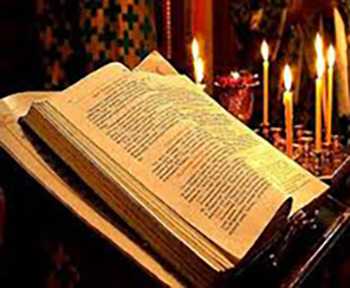
ISAIAH 7:1-15
1 Now it came to pass in the days of Ahaz the son of Jotham, the son of Uzziah, king of Judah, that Rezin king of Syria and Pekah the son of Remaliah, king of Israel, went up to Jerusalem to make war against it, but could not prevail against it. 2 And it was told to the house of David, saying, “Syria’s forces are deployed in Ephraim.” So his heart and the heart of his people were moved as the trees of the woods are moved with the wind. 3 Then the Lord said to Isaiah, “Go out now to meet Ahaz, you and Shear-Jashub your son, at the end of the aqueduct from the upper pool, on the highway to the Fuller’s Field, 4 “and say to him: ‘Take heed, and be quiet; do not fear or be fainthearted for these two stubs of smoking firebrands, for the fierce anger of Rezin and Syria, and the son of Remaliah. 5 Because Syria, Ephraim, and the son of Remaliah have plotted evil against you, saying, 6 “Let us go up against Judah and trouble it, and let us make a gap in its wall for ourselves, and set a king over them, the son of Tabel”— 7 ‘thus says the Lord God: “It shall not stand, Nor shall it come to pass. 8 For the head of Syria is Damascus, And the head of Damascus is Rezin. Ephraim will be broken within sixty-five years, so it will not be a people. 9 The head of Ephraim is Samaria, And the head of Samaria is Remaliah’s son. If you will not believe, Surely you shall not be established.” 10 Moreover, the Lord spoke again to Ahaz, saying, 11 “Ask a sign for yourself from the Lord your God; ask it either in the depth or in the height above.” 12 But Ahaz said, “I will not ask, nor will I test the Lord!” 13 Then he said, “Hear now, O house of David! Is it small for you to weary men, but will you weary my God also? 14 “Therefore the Lord Himself will give you a sign: Behold, the virgin shall conceive and bear a Son, and shall call His name Immanuel. 15 “Curds and honey He shall eat, that He may know to refuse the evil and choose the good.
GENESIS 5:32-6:8
32 And Noah was five hundred years old, and Noah begot Shem, Ham, and Japheth.
1 Now it came to pass, when men began to multiply on the face of the earth, and daughters were born to them, 2 that the sons of God saw the daughters of men, that they were beautiful; and they took wives for themselves of all whom they chose. 3 And the Lord said, “My Spirit shall not strive with man forever, for he is indeed flesh; yet his days shall be one hundred and twenty years.” 4 There were giants on the earth in those days, and also afterward, when the sons of God came in to the daughters of men and they bore children to them. Those were the mighty men who were of old, men of renown. 5 Then the Lord saw that the wickedness of man was great in the earth, and that every intent of the thoughts of his heart was only evil continually. 6 And the Lord was sorry that He had made man on the earth, and He was grieved in His heart. 7 So the Lord said, “I will destroy man whom I have created from the face of the earth, both man and beast, creeping thing and birds of the air, for I am sorry that I have made them.” 8 But Noah found grace in the eyes of the Lord.
#orthodoxy#orthodoxchristianity#easternorthodoxchurch#originofchristianity#spirituality#holyscriptures#bible#wisdom#saints
1 note
·
View note
Note
Hi Hilary! First of all, I need you to know that you have my utmost respect for how patiently and thoroughly you keep analyzing and explaining the current political clusterfuck regarding *gestures vaguely at everything*. That said, if you feel like a short break from that, I've got an entirely selfish question: if the two dudes in the fic I'm thinking of writing were very old vampires (like 1500 years or the like), what would be a good historical event for them to have vastly conflicting takes on where both viewpoints are more or less equally valid and they can have, uh, heated arguments? Sending you lots of positive vibes 💕
Thank you, my dear. Oh God, how I long for a break from All This Fucking Shit, but I suspect, unfortunately, that all the Shit will keep happening whether I want it to or not, so I have to figure out how to deal with that. On the other hand, I am MORE than happy to talk about something else, and this is an obviously delightful question.
There are a few good choices for your vampires to argue about, depending on exactly how old they are and where in the world they come from. The first possibility is the Council of Nicaea in 325 CE, which set what we recognize as Catholic Christian doctrine and formally outlawed all the other competing textual interpretations. This was the culmination of a HUGE knock-down, drag-out fight, between western and eastern theologies that tried to precisely define the relation of Jesus Christ to God the Father, whether he actually had a human body, whether he had ever actually committed a sin, whether he had ever physically died, and etc. There were countless sects and branches of various size and influence, usually named after their most prominent intellectual figure; i.e., Arianism, Marcionism, etc etc. After two hundred years of heated nerd fights, the Council of Nicaea tried to settle them in the favor of establishing a unified Christian creed (this is where we get the Nicene Creed). If your vampires are of a religious, philosophical, or particular regional bent (since certain geographic areas were more affiliated with certain strands of "heresy" than others), this is an excellent way for them to have the most bogglingly obscure technical/theological arguments known to mankind. MARCIONISM IS JUST REPACKAGED GNOSTICISM!!! yells one. INTOLERANT SANCTIMONIOUS NICENE BASTARD! yells the other. OH MY GOD, GET A ROOM AND ALSO SOME EARPLUGS FOR US, yells everyone else.
Likewise, they could also argue about Justinian and Theodora, Emperor and Empress of the Byzantine Empire in the mid-sixth century (527-65 for Justinian and 527-48 for Theodora). The Secret History by the Byzantinian historian Procopius is both wildly entertaining and shall we say, uh, colorful, and contains all kinds of sexual innuendos and slander about them, particularly Theodora. Justinian was the most influential ruler of the time, there are plenty of political events for the vampires to disagree on, angst related to losing loved ones in the Plague of Justinian, whether Theodora was a no-good scheming con woman or a powerful ambitious badass, what exactly Procopius was smoking, and so forth. They could also argue endlessly over who was really responsible for the end of the Western Roman Empire (c. 476): was it the barbarians, the bad emperors, the endless wars, the overexpansion, the taxes, the natural limits of effective control, etc.? They could also take sides on Carthage v. Rome, though Hannibal and his elephants are much earlier (3rd century BC) and the vampires, unless they're even older, would probably not have known him personally. One of them could likewise have a terrible grudge against the Goths for sacking Rome in 410, and amusingly mistakes every modern "goth" in black nail polish and a spiky collar for a Descendant of the Enemy, while the other one is like oh my god you idiot.
Anyway, if you want more options, let me know, as I am nothing if not good for generating obscure historical background context for fic. We all have to have our talents. :)
41 notes
·
View notes
Text
Today the Church honors St. Paphnutius, Confessor of the Faith.
Ora pro nobis.
The holy confessor Paphnutius was an Egyptian who, after having spent several years in the desert under the direction of St. Antony the Great, was made bishop in the Upper Thebaid in Egypt. He was one of those confessors who, under the persecution of Christians under Emperor Maximinus (AD 310-313), was blinded in the right eye and hamstrung in one leg, and were afterwards condemned to work in the mines. With the promulgation of the Edict of Milan by the Emperor Constantine in AD 313, Christianity became a legal religion in the Roman Empire, and all imprisoned Christians were set free. Paphnutius returned to his flock, bearing all the rest of his life the glorious marks of his sufferings for the name of his Crucified Master.
He was one of the most zealous in defending the orthodox Faith of the Church against the Arian heresy. He was also highly regarded for his holiness of life. As one who had confessed the Faith before persecutors and under torments, he was an outstanding figure of the first General Council of the Church, held at Nicaea in the year AD 325. Paphnutius, a man who had observed the strictest continence all his life, is said to have distinguished himself at the Council by his opposition to a new requirement of clerical celibacy. Paphnutius said that it was enough to conform to the ancient tradition of the Church, which restricted the clergy from marrying after their ordination, but to require married clergy to abandon their wives was unacceptable to the Gospel of Jesus. His voice won the day, and to this day it is the law of the Eastern Churches, whether Catholic or Orthodox, that married men may be ordained deacon and priest, though bishops are chosen only from celibate monastics, and continue to live freely with their wives.
St. Paphnutius is sometimes called "the Great" to distinguish him from other saints of the same name. The exact year of his death is not known, but was certainly in the early 4th c. AD.
Almighty God, you have surrounded us with a great cloud of witnesses: Grant that we, encouraged by the good example of your faithful servant Paphnutius, may persevere in running the race that is set before us, until at last we may with him attain to your eternal joy; through Jesus Christ, the pioneer and perfecter of our faith, who lives and reigns with you and the Holy Spirit, one God, forever and ever.
Amen.
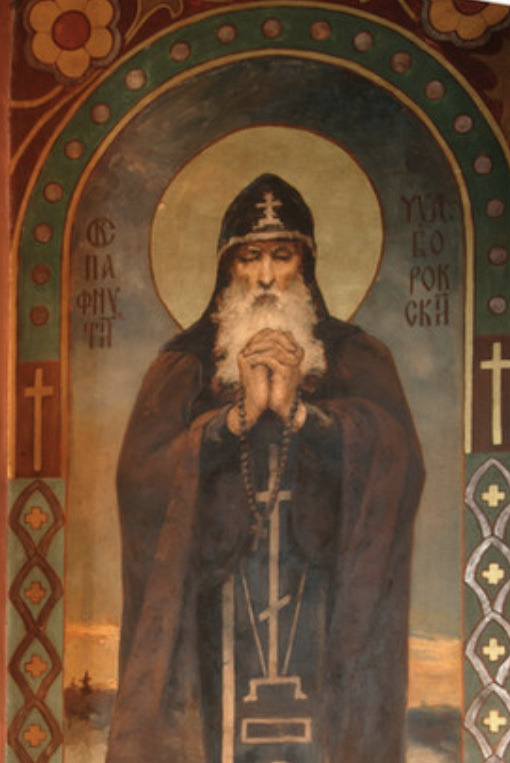
3 notes
·
View notes
Photo

Council of Chalcedon
The Council of Chalcedon was called in 451 CE by the Roman Emperor Marcian (r. 450-457) to settle debates regarding the nature (hypostases, "reality") of Christ that had begun at two earlier meetings in Ephesus (431 CE and 439 CE). The question was whether Christ was human or divine, a man who became God (through the resurrection and ascension) or God who became a man (through the incarnation, "taking on flesh"), and how his humanity and divinity affected his essence and being, if at all.
Shortly after Emperor Constantine's conversion to Christianity in 312 CE, an Alexandrian presbyter, Arius, applying logic, had simply taught that if God created everything in the universe, then at some point he must have created Christ. This caused debates and even riots throughout the cities of the Roman Empire. If Christ was a creature, then he was subordinate to God. Seeking empire-wide unity, Constantine I (r. 306-337 CE) called for a council meeting at Nicaea in 325 to settle the matter.
The First Council of Nicaea produced what became known as the concept of the Trinity. This concept expressed the belief that Christ was of the identical essence of God, who had manifested himself in the earthly Jesus of Nazareth. It produced the innovation of a creed that dictated what all Christians should believe. The Nicene Creed was now enforced by the legions of the Roman emperor, and Arianism was condemned as heresy. However, those who sided with Arius continued to incorporate his teachings in their communities. One of Constantine's sons, Constantius II (r. 337-361 CE), was an Arian Christian.
With the beginning of the barbarian invasions in this period, Christians were urged to be patriotic Christians, in line with the Imperial Church. However, the Antiochene and Alexandrian communities continued to debate which emperors had such authority (legitimacy), depending upon their views of continuing Arianism at their courts and other topics. The other problem was that the Council of Nicaea only addressed the relationship between God and Christ but said nothing about his nature.
Struggle Among the Sees
For several centuries, Christian bishops had competed with each other in relation to who had the authority to dictate beliefs and rituals for all Christians. The major sees (dioceses) of bishops were Jerusalem, Antioch, Alexandria, Constantinople, and Rome. The First Council of Constantinople in 381 elevated Rome above all others (as the site of martyrdom of Saint Peter and Paul the Apostle). Alexandria, which had several Christian schools of philosophy, saw this as an insult to their prestige. Antioch resented it because they claimed their community was the first to be called Christians (from Luke's Acts of the Apostles). Jerusalem was the most insulted, as this was the site of the trial and crucifixion of Jesus of Nazareth and his resurrection. Thrown into this mix were three more heresies that ultimately required more imperial anathemas and dictates: Paulinism, Novatianism, and Nestorianism.
Continue reading...
20 notes
·
View notes
Note
Do you have any recs for books on the heresies of the Late Roman Empire? For some reason I am endlessly fascinated with (early) Christian heresies.
Cameron (Cambridge) and Mitchell (Blackwell) are good one-volume introductions to the late Roman Empire, but if you want stuff specifically about heresy, I'd recommend:
Maijastina Kahlos, Religious Dissent in Late Antiquity.
Baker ed. Schism, Heresy and Religious Protest.
Lewis Ayres, Nicaea and Its Legacy.
Iricinschi and Zellentin, ed. Heresy and Identity in Late Antiquity.
Berndt and Steinacher ed. Arianism.
14 notes
·
View notes